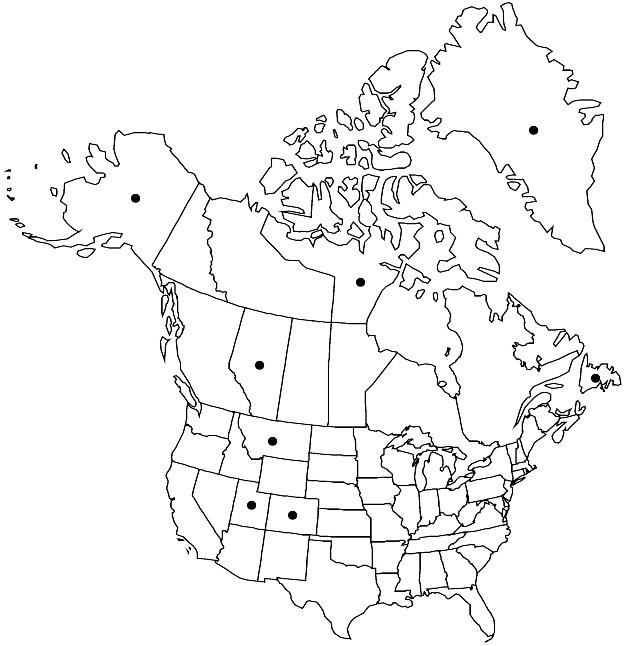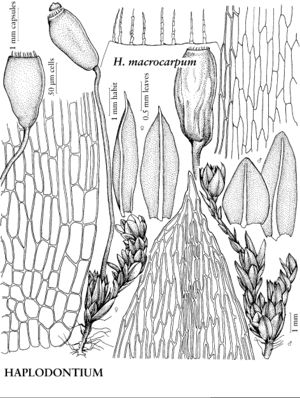Difference between revisions of "Haplodontium macrocarpum"
Phytologia 87: 26. 2005.
FNA>Volume Importer |
FNA>Volume Importer |
||
| Line 18: | Line 18: | ||
|name=Bryum porsildii | |name=Bryum porsildii | ||
|authority=(I. Hagen) C. J. Cox & Hedderson | |authority=(I. Hagen) C. J. Cox & Hedderson | ||
| − | }}{{Treatment/ID/Synonym | + | }} {{Treatment/ID/Synonym |
|name=Mielichhoferia macrocarpa | |name=Mielichhoferia macrocarpa | ||
|authority=(Hooker) Bruch & Schimper ex A. Jaeger & Sauerbeck | |authority=(Hooker) Bruch & Schimper ex A. Jaeger & Sauerbeck | ||
| Line 36: | Line 36: | ||
|elevation=low to high elevations (0-3500 m) | |elevation=low to high elevations (0-3500 m) | ||
|distribution=Greenland;Alta.;Nfld. and Labr. (Nfld.);Nunavut;Alaska;Colo.;Mont.;Utah;Eurasia (ne Russia). | |distribution=Greenland;Alta.;Nfld. and Labr. (Nfld.);Nunavut;Alaska;Colo.;Mont.;Utah;Eurasia (ne Russia). | ||
| − | |discussion=<p>Although Haplodontium macrocarpum is associated with mineral-rich rock, collections come from a wide variety of rock types. In the southern and central Rocky Mountains, the species is apparently restricted to limestone. Some specimens from the Aleutian Islands have a strongly excurrent costa, and in some respects approach the Asian Mielichhoferia (Haplodontium) himalayana Mitten.</p><!-- | + | |discussion=<p>Although <i>Haplodontium macrocarpum</i> is associated with mineral-rich rock, collections come from a wide variety of rock types. In the southern and central Rocky Mountains, the species is apparently restricted to limestone. Some specimens from the Aleutian Islands have a strongly excurrent costa, and in some respects approach the Asian <i>Mielichhoferia</i> (<i>Haplodontium</i>) himalayana Mitten.</p><!-- |
--><p>of conservation concern</p> | --><p>of conservation concern</p> | ||
|tables= | |tables= | ||
| Line 61: | Line 61: | ||
|publication year=2005 | |publication year=2005 | ||
|special status=Selected by author to be illustrated | |special status=Selected by author to be illustrated | ||
| − | |source xml=https://jpend@bitbucket.org/aafc-mbb/fna-data-curation.git/src/ | + | |source xml=https://jpend@bitbucket.org/aafc-mbb/fna-data-curation.git/src/8f726806613d60c220dc4493de13607dd3150896/coarse_grained_fna_xml/V28/V28_226.xml |
|genus=Haplodontium | |genus=Haplodontium | ||
|species=Haplodontium macrocarpum | |species=Haplodontium macrocarpum | ||
Revision as of 17:04, 18 September 2019
Plants pale light green to pink-green, red-brown to brown proximally. Stems 0.5–3 cm, not julaceous, weakly to strongly branched. Leaves flexuose to weakly secund when dry, erect when moist, ovate to oblong or broadly lanceolate, 0.6–2 mm; margins narrowly revolute proximally; apex broadly acute to sometimes acuminate, apiculus absent or rarely present; costa subpercurrent to percurrent, rarely short-excurrent to excurrent in hair-point, pale tan-brown or red; laminal cells 40–120 × 10–18 µm; distal cells at apex elongate. Seta yellow-brown, 0.4–1.2 cm, curved to flexuose. Capsule erect to nutant, subglobose to short-pyriform, 1.3–2.5 mm; operculum flat to weakly convex, weakly apiculate; peristome single. Spores 12–20(–24) µm, smooth or finely papillose.
Phenology: Capsules mature Jul–Aug (summer).
Habitat: Damp to seepy rock faces, crevices, limestone, arctic-alpine
Elevation: low to high elevations (0-3500 m)
Distribution

Greenland, Alta., Nfld. and Labr. (Nfld.), Nunavut, Alaska, Colo., Mont., Utah, Eurasia (ne Russia).
Discussion
Although Haplodontium macrocarpum is associated with mineral-rich rock, collections come from a wide variety of rock types. In the southern and central Rocky Mountains, the species is apparently restricted to limestone. Some specimens from the Aleutian Islands have a strongly excurrent costa, and in some respects approach the Asian Mielichhoferia (Haplodontium) himalayana Mitten.
of conservation concern
Selected References
None.
